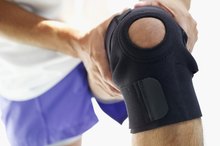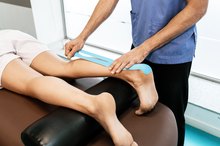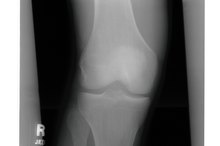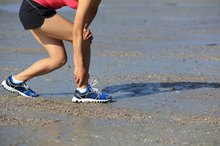The Best Way to Heal a Torn Calf Muscle
Your calf, or gastrocnemius muscle, can easily become strained during exercise or sports that quickly change direction, such as basketball or tennis. Muscle strains can be minor, stretching muscle fibers until mildly tender, or strains can involve complete muscle tears, resulting in stronger pain and additional symptoms. Recovery ranges according to the severity of the injury and may even require surgery. Speak with your doctor for diagnosis and specific recovery instructions regarding your particular injury.
Symptoms
Symptoms for a torn calf muscle depend on its severity-based grade. Grade I, where only some fibers are stretched or torn, produces mild tenderness and some pain, but the muscle's strength remains intact. Grade II is slightly more severe, pain and tenderness are modestly increased with additional swelling, reduced strength and possible bruising. Grade III is the most severe, with muscles torn all the way through and a complete loss of muscle function. A dent or gap under the skin may be seen where muscle has ripped and may only be repaired by surgery.
- Symptoms for a torn calf muscle depend on its severity-based grade.
- Grade III is the most severe, with muscles torn all the way through and a complete loss of muscle function.
R.I.C.E.
Rehab Exercises After MCL Injury
Learn More
If your doctor diagnoses your tear as Grade I or II, your immediate treatment begins with RICE: rest, ice, compression and elevation, advises InteliHealth.com, Aetna's Harvard Medical School reviewed website. Rest the affected muscle by not standing or walking. Apply ice in 10 minute intervals throughout the day, with 10 minutes on and 10 minutes off, as recommended by FootEducation.com, a website written by orthopaedic surgeons. Light compression with an elastic bandage may be helpful, along with elevation of the calf muscle, in which your leg is slightly higher than your heart. A Grade III diagnosis may require X-rays, MRI or Doppler testing.
- If your doctor diagnoses your tear as Grade I or II, your immediate treatment begins with RICE: rest, ice, compression and elevation, advises InteliHealth.com, Aetna's Harvard Medical School reviewed website.
- Light compression with an elastic bandage may be helpful, along with elevation of the calf muscle, in which your leg is slightly higher than your heart.
Additional Treatments
Over-the-counter anti-inflammatory medicines, such as acetaminophen, ibuprofen or aspirin may be taken according to package directions to relieve swelling and pain. Additionally, wearing a splint that keeps your ankle in a neutral position may speed healing, according to FootEducation.com. Begin to bear weight on your affected leg only when tolerable; using crutches may be helpful until you have healed enough to handle walking.
Recovery
Symptoms of a Torn Calf Muscle
Learn More
After pain has subsided, it may be safe to begin stretching exercises along with massage therapy. Gradually increase your exercises to include cycling, leg presses and heel raises. After at least one week off your feet, consider the following secret recovery tip for runners with calf injuries from publisher and editorial director of "Running Times," John L. Parker. Use a track or treadmill with a flat, controlled surface to walk one mile. Jog carefully for a few hundred yards, then walk again. Continue alternating through your workout, but stop if your calf grows numb or sore. Parker advises a day of rest before walking or jogging again, then gradually increase the jogging portion until you are back to your regular routine.
- After pain has subsided, it may be safe to begin stretching exercises along with massage therapy.
- Parker advises a day of rest before walking or jogging again, then gradually increase the jogging portion until you are back to your regular routine.
Related Articles
References
- The Stick: Calf Heart Attacks
- FootEducation: Calf Muscle Tear (Gastrocnemius Tear)
- InteliHealth.com: Leg Strain
- Bryan Dixon J. Gastrocnemius vs. soleus strain: how to differentiate and deal with calf muscle injuries. Curr Rev Musculoskelet Med. 2009;2(2):74-7. doi:10.1007/s12178-009-9045-8
- Dixon JB. Gastrocnemius vs. soleus strain: how to differentiate and deal with calf muscle injuries. Current Reviews in Musculoskeletal Medicine. 2009;2(2):74-77.
Writer Bio
Writing since 1978, Allison Stevens was writer and publisher of the Calvary Christian Fellowship newsletter and has had work appear in various online publications. Stevens has certification to teach group fitness and is a licensed Zumba instructor, teaching fitness classes for adults and children daily. She enjoys researching various subjects including health, and holds an Associate of Arts.









